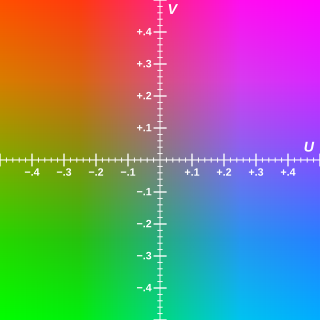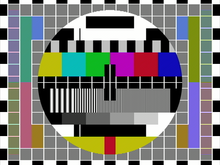
Analog television is the original television technology that uses analog signals to transmit video and audio. In an analog television broadcast, the brightness, colors and sound are represented by amplitude, phase and frequency of an analog signal.

Chrominance is the signal used in video systems to convey the color information of the picture, separately from the accompanying luma signal. Chrominance is usually represented as two color-difference components: U = B′ − Y′ (blue − luma) and V = R′ − Y′ (red − luma). Each of these different components may have scale factors and offsets applied to it, as specified by the applicable video standard.

NTSC is the first American standard for analog television, published in 1941. In 1961, it was assigned the designation System M. It is also known as EIA standard 170.

Phase Alternating Line (PAL) is a colour encoding system for analogue television. It was one of three major analogue colour television standards, the others being NTSC and SECAM. In most countries it was broadcast at 625 lines, 50 fields per second, and associated with CCIR analogue broadcast television systems B, D, G, H, I or K. The articles on analog broadcast television systems further describe frame rates, image resolution, and audio modulation.

SECAM, also written SÉCAM, is an analog color television system that was used in France, Russia and some other countries or territories of Europe and Africa. It was one of three major analog color television standards, the others being PAL and NTSC. Like PAL, a SECAM picture is also made up of 625 interlaced lines and is displayed at a rate of 25 frames per second. However, due to the way SECAM processes color information, it is not compatible with the German PAL video format standard. This page primarily discusses the SECAM colour encoding system. The articles on broadcast television systems and analog television further describe frame rates, image resolution, and audio modulation. SECAM video is composite video because the luminance and chrominance are transmitted together as one signal.

Y′UV, also written YUV, is the color model found in the PAL analogue color TV standard. A color is described as a Y′ component (luma) and two chroma components U and V. The prime symbol (') denotes that the luma is calculated from gamma-corrected RGB input and that it is different from true luminance. Today, the term YUV is commonly used in the computer industry to describe colorspaces that are encoded using YCbCr.

Composite video is an analog video format that typically carries a 525 or 625 line signal on a single channel, unlike the higher-quality S-Video and the even higher-quality component video.

Chroma subsampling is the practice of encoding images by implementing less resolution for chroma information than for luma information, taking advantage of the human visual system's lower acuity for color differences than for luminance.

SMPTE color bars are a television test pattern used where the NTSC video standard is utilized, including countries in North America. The Society of Motion Picture and Television Engineers (SMPTE) refers to the pattern as Engineering Guideline (EG) 1-1990. Its components are a known standard, and created by test pattern generators. Comparing it as received to the known standard gives video engineers an indication of how an NTSC video signal has been altered by recording or transmission and what adjustments must be made to bring it back to specification. It is also used for setting a television monitor or receiver to reproduce NTSC chrominance and luminance information correctly.
Because the NTSC color television standard relies on the absolute phase of the color information, color errors occur when the phase of the video signal is altered between source and receiver, or due to non linearities in electronics. To correct for phase errors, a tint control is provided on NTSC television sets, which allows the user to manually adjust the phase relationship between the color information in the video and the reference for decoding the color information, known as the "color burst", so that correct colors may be displayed.

A Vectorscope is a special type of oscilloscope used in both audio and video applications. Whereas an oscilloscope or waveform monitor normally displays a plot of signal vs. time, a vectorscope displays an X-Y plot of two signals, which can reveal details about the relationship between these two signals. Vectorscopes are highly similar in operation to oscilloscopes operated in X-Y mode; however those used in video applications have specialized graticules, and accept standard television or video signals as input.
Burst phase is the first ten cycles of colorburst in the "porch" of the synchronising pulse in the PAL broadcast television systems format. The frequency of this burst is 4.43361875 MHz; it is precise to .5 Hz, and is used as the reference frequency to synchronise the local oscillators of the colour decoder in a PAL television set.
MUSE, commercially known as Hi-Vision was a Japanese analog high-definition television system, with design efforts going back to 1979.
PAL-S is the system of television receiver sets in the early days of the PAL system. Here PAL stands for Phase alternating at line rate and S stands for simple.
The color killer is an electronic stage in color TV receiver sets which acts as a cutting circuit to cut off color processing when the TV set receives a monochrome signal.

625-line is a late 1940s European analog standard-definition television resolution standard. It consists of a 625-line raster, with 576 lines carrying the visible image at 25 interlaced frames per second. It was eventually adopted by countries using 50 Hz utility frequency as regular TV broadcasts resumed after World War II. With the introduction of color television in the 1960s, it became associated with the PAL and SECAM analog color systems.
This glossary defines terms that are used in the document "Defining Video Quality Requirements: A Guide for Public Safety", developed by the Video Quality in Public Safety (VQIPS) Working Group. It contains terminology and explanations of concepts relevant to the video industry. The purpose of the glossary is to inform the reader of commonly used vocabulary terms in the video domain. This glossary was compiled from various industry sources.

525-line is an American standard-definition television resolution used since July 1, 1941, mainly in the context of analog TV broadcast systems. It consists of a 525-line raster, with 480 lines carrying the visible image at 30 interlaced frames per second. It was eventually adopted by countries using 60 Hz utility frequency as TV broadcasts resumed after World War II. With the introduction of color television in the 1950s, it became associated with the NTSC analog color standard.

The TVE colour test card was an electronic analogue TV test card adopted by Televisión Española with the introduction of PAL colour broadcasts in 1975. It is notable for its unique design, created by the Danish engineer Finn Hendil (1939–2011) in 1973, under the supervision of Erik Helmer Nielsen at the Philips TV & Test Equipment laboratory in Amager, south of Copenhagen, the same team that developed the popular Philips PM5544 test pattern. It replaced a previous black and white version developed by Eduardo Gavilán.
Clear-Vision is a Japanese EDTV television system introduced in the 1990s, that improves audio and video quality while remaining compatible with the existing broadcast standard. Developed to improve analog NTSC, it adds features like progressive scan, ghost cancellation and widescreen image format. A similar system named PALPlus was develop in Europe with the goal of improving analog PAL broadcasts.











